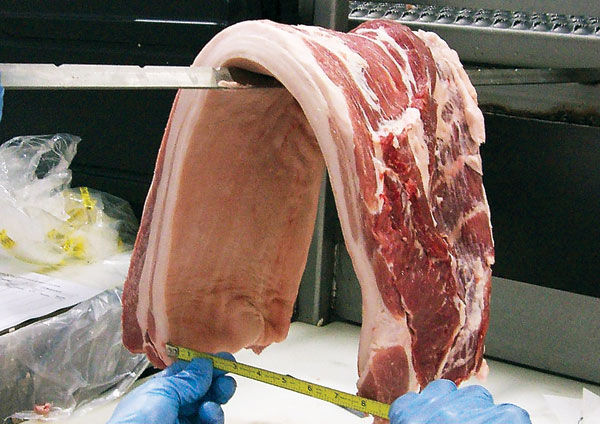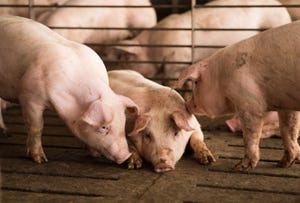How Much Distiller’s Grain is Too Much?
February 29, 2012

Any way you slice it, bacon appeals to the American palate. “Right now, bacon is where the money is as one of the hottest commodities on the pig, up there in price with the loin,” says Marcia Shannon, University of Missouri Extension (MU) swine researcher.
MU Extension researchers recently collaborated with other universities to figure out what mix of feed works best to finish out hogs while creating better bacon for the breakfast plate. Study results found that by tapering off or eliminating distiller’s grain in the last month of feeding, carcasses will have firmer fat and be of better quality, and producers will still save money.
“When consumers buy bacon at the grocery store they want it to be firm, not mushy, and that quality issue can hinge on what producers feed their pigs,” Shannon says.
The balance of quality and economics begins with dried distiller’s grain. Many producers feed their pigs distiller’s grain, a cheap feed alternative that supplements traditional corn and soybean meal. This byproduct of ethanol production essentially is corn without the starch. Record high corn prices in the past several years makes distiller’s grain a particularly appealing alternative, causing some producers to use up to 45% of it in their feed rations.
While high in nutrients, distiller’s grain just doesn’t fatten hogs out the same way as regular corn.
“Our study two years ago found that up to 45% of distiller’s grain in feed didn’t hurt performance, but did impact belly firmness,” Shannon says.
Belly firmness is how scientists talk about bacon quality. Firmer bellies, or firmer fat, mean less unsaturated fat and more meat from each pig. “With firmer belly fat, a processor can get more bacon slices out of a side of pork because it’s easier to slice,” she says.
This quality falters when hogs eat too much distiller’s grain.
“Too much distiller’s grain softens fat,” Shannon says. “We wanted to be able to feed high amounts of distiller’s grain and not have that detrimental aspect of poorer pork quality,” she says.
MU Extension and nine other universities studied 580 pigs from weaning to market. Researchers fed five different diets to different groups of pigs. Diets ranged from rations with no distiller’s grain to rations with 33.5% distiller’s grain. Some diets had a constant proportion of distiller’s grain, some tapered off distiller’s grain for the last 140 lb. and others eliminated it for the final 70 lb. to a finished pig.
Results confirmed that cutting off the supply of distiller’s grain improves quality.
“If you feed 33.5% of distiller’s grain all the way up to market, you’re going to have a soft fat problem,” Shannon says. “If feeding more than 20%, we recommend pulling distiller’s grain from the diet at least two weeks before market in order to have desirable belly firmness or fat quality.”
The study manually measured belly firmness and took iodine values of carcasses. Iodine values quantify the amount of undesirable, unsaturated fat and confirmed the manual measurements.
The only drawback of finishing pigs this way is that hogs eating distiller’s grain will need to be fed for about six more days since they gain 10% less weight per day.
That trade-off is still well worth it for most producers.
“You can see that there’s a slight reduction in performance, but not significant,” Shannon says. “When you’re looking at carcass quality as well as performance, most producers can justify feeding at least 20% distiller’s grain.”
This research is organized by the North Central Coordinating Committee on Swine Nutrition, which has linked swine researchers from universities like MU in collaborative research for more than 40 years.
Read more about MU Extension’s swine research at www.agebb.missouri.edu/commag/swine.
You May Also Like



